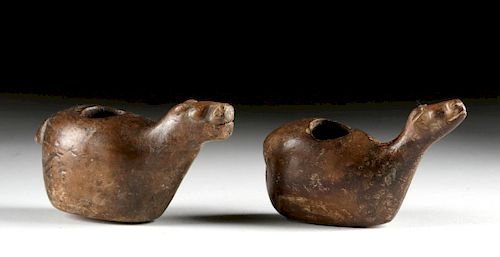Rare Inca Wooden Canopas - Llama Form (pr)
Lot 184a
About Seller
Artemis Fine Arts
686 S Taylor Ave, Ste 106
Louisville, CO 80027
United States
Selling antiquities, ancient and ethnographic art online since 1993, Artemis Gallery specializes in Classical Antiquities (Egyptian, Greek, Roman, Near Eastern), Asian, Pre-Columbian, African / Tribal / Oceanographic art. Our extensive inventory includes pottery, stone, metal, wood, glass and textil...Read more
Estimate:
$1,500 - $2,250
Absentee vs Live bid
Two ways to bid:
- Leave a max absentee bid and the platform will bid on your behalf up to your maximum bid during the live auction.
- Bid live during the auction and your bids will be submitted real-time to the auctioneer.
Bid Increments
| Price | Bid Increment |
|---|---|
| $0 | $25 |
| $300 | $50 |
| $1,000 | $100 |
| $2,000 | $250 |
| $5,000 | $500 |
| $10,000 | $1,000 |
| $20,000 | $2,500 |
| $50,000 | $5,000 |
| $100,000 | $10,000 |
| $200,000 | $20,000 |
About Auction
By Artemis Fine Arts
Jun 20, 2019
Set Reminder
2019-06-20 10:00:00
2019-06-20 10:00:00
America/New_York
Bidsquare
Bidsquare : Ancient / Ethnographic From Around the World
https://www.bidsquare.com/auctions/artemis-gallery/ancient-ethnographic-from-around-the-world-4217
Around the world & back in time - be amazed at the treasures you will find. Antiquities from Egypt, Greece, Italy and the Near East, Asian, Pre-Columbian, African / Tribal / Oceanic, Native American, Spanish Colonial, Russian Icons, Fine Art, much more! All categories, all price ranges.. all legal Artemis Fine Arts info@artemisfinearts.com
Around the world & back in time - be amazed at the treasures you will find. Antiquities from Egypt, Greece, Italy and the Near East, Asian, Pre-Columbian, African / Tribal / Oceanic, Native American, Spanish Colonial, Russian Icons, Fine Art, much more! All categories, all price ranges.. all legal Artemis Fine Arts info@artemisfinearts.com
- Lot Description
Pre-Columbian, South/Central Coast Peru, Incan Empire, ca. 1200 to 1532 CE. A wondrous set of two identical vessels, hand-carved from a caramel-hued wood, with round but stable bases and hollowed-out interiors. These small wooden vessels, called "canopas," are the most common ritual effigies known from the Incan Empire. Typically depicting llamas, alpacas, or other camelids, canopas are often buried in the animals' corrals to protect the herds and symbolically increase their fertility. These particular containers depict a set of llamas, one male and one female indicated by the size of the heads and necks, with bulbous bodies and perky tails. The cavity on the back of each vessel would have been filled with offerings like coca leaves, maize, or animal fat in order to appease the gods. Wooden artifacts are incredibly scarce to find let alone intact, so this is an exceedingly rare matched set! Size of largest (male - larger head): 4" L x 1.5" W x 2.125" H (10.2 cm x 3.8 cm x 5.4 cm).
Provenance: private Hawaii, USA collection; ex-Hans Juergen Westermann collection, Germany
All items legal to buy/sell under U.S. Statute covering cultural patrimony Code 2600, CHAPTER 14, and are guaranteed to be as described or your money back.
A Certificate of Authenticity will accompany all winning bids.
We ship worldwide and handle all shipping in-house for your convenience.
#143741Both vessels have light abrasions and nicks to heads, bodies, and bases, light encrustations, and a couple of stable hairline fissures, otherwise intact and excellent. Light earthen deposits and great patina throughout. Old inventory labels beneath base of each vessel.Condition
- Shipping Info
-
All shipping is handled in-house for your convenience. Your invoice from Artemis Gallery will include shipping calculation instructions. If in doubt, please inquire BEFORE bidding for estimated shipping costs for individual items.
-
- Buyer's Premium



 EUR
EUR CAD
CAD AUD
AUD GBP
GBP MXN
MXN HKD
HKD CNY
CNY MYR
MYR SEK
SEK SGD
SGD CHF
CHF THB
THB












